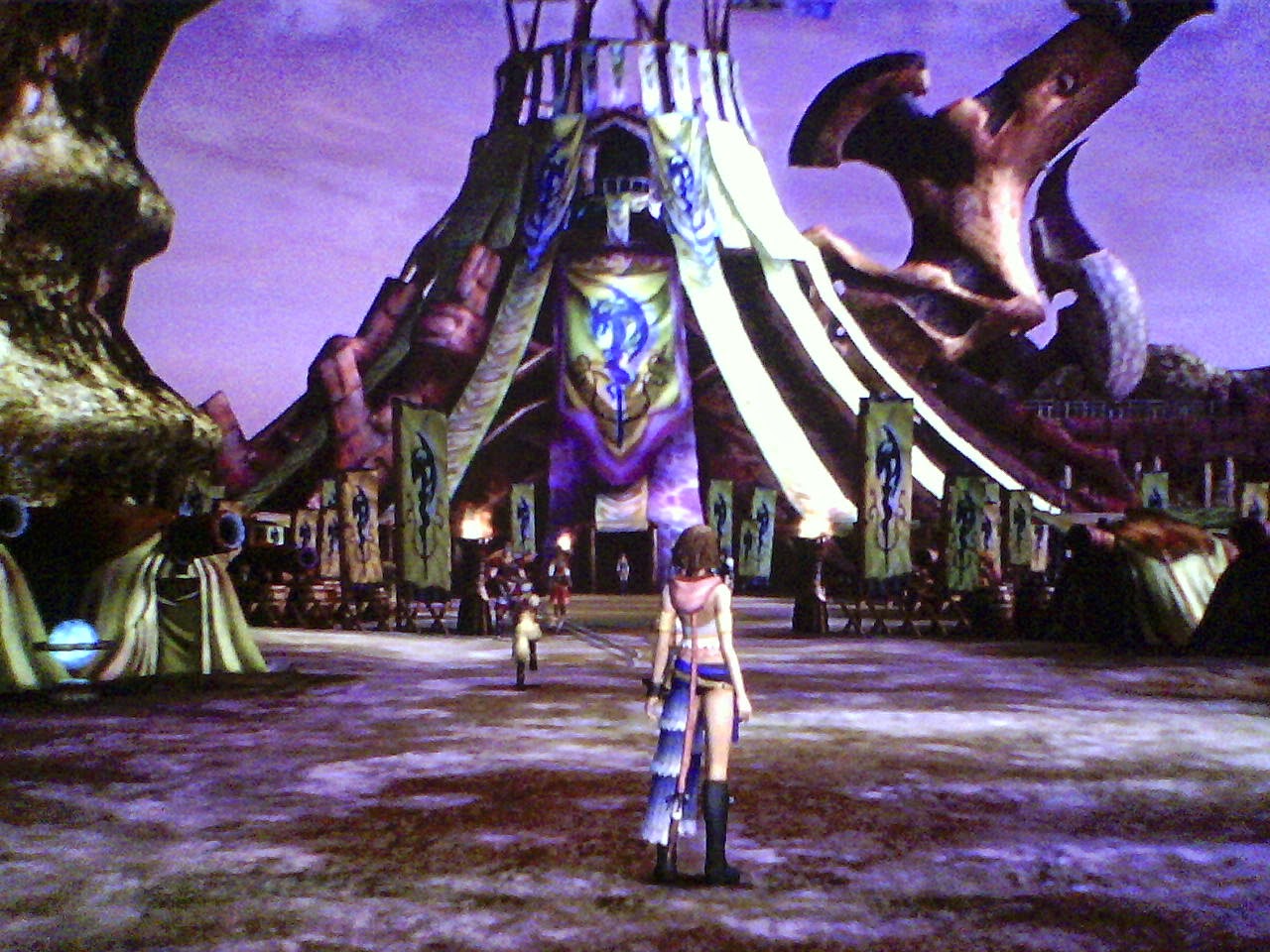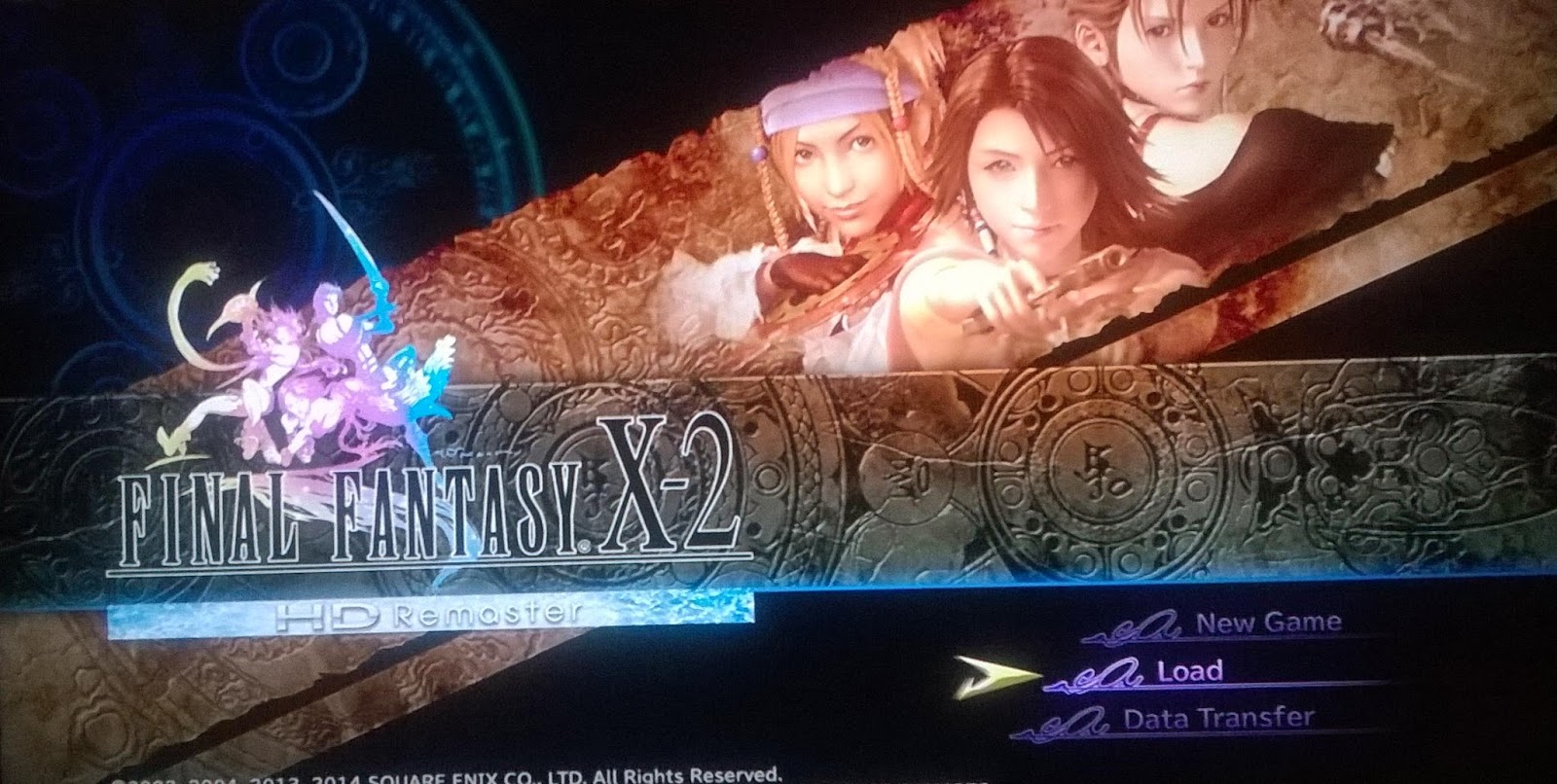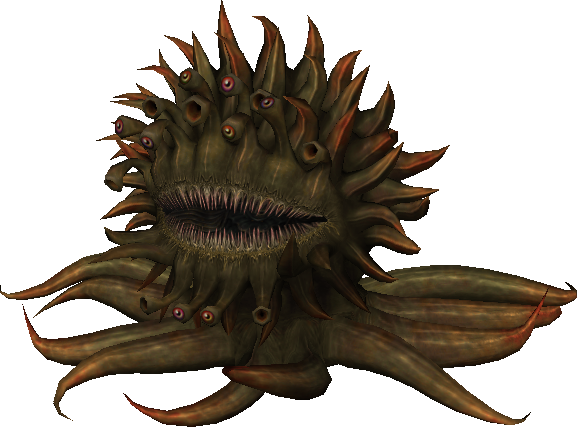Our heroes made it to Zanarkand, the goal of the pilgrimage. However, what awaited them there?
 |
| The ruined "dome" in Zanarkand. It bears a resemblance to the blitzball stadium depicted in the game's opening sequence. |
Although it's not the end game, I think the guardians arrival in Zanarkand is the climax; certainly so of the storyline. The storyline builds and throws twists at the player relentlessly, and gaining the "Final Aeon" is no exception. Final Fantasy X boasts a fleshed out world with a very interesting and detailed background. I considered summarizing it here for those who might not wish to play the game, but in the interest of blog time, and to not spoil it, I'll just recommend playing the game. If you hate playing games like this with a passion and just can't see yourself giving it a go, I think the story is worth a read honestly. There is likely a summary up somewhere on the 'nets. I can't resist a little tease, basically everything that the Yevonites of Spira have been taught to believe in is built on half-truths and political rhetoric, and it all comes to a head dramatically in Zanarkand.
After Zanarkand, the heroes now must seek a way to defeat Sin. First, they make Sin somewhat docile by encouraging all the folk of Spira to sing a song, "The Hymn of the Fayth". This is a song sung by the fayth themselves that Tidus's father particularly liked. Once Sin is calmed, the guardians attack with the airship's help, and fight a triple battle with Sin.
 |
| "We're gonna get you Sin!" |
 |
| "Oh good Yevons!" If the guardians do not defeat Sin before it's overdrive gauge fills, they are met with probably the only instant game over in the game. |
These battle sequences depict for the first time in the game anyone having any real success battling Sin. It's interesting, for the first time the characters, and you, feel like Sin might be on the ropes and there is some chance of defeating it. This contrasts sharply with the rest of the game, where Sin seems invincible, and inevitable.
 |
| The airship drops the heroes off inside Sin, at the "Sea of Sorrows." |
Like most of today's RPGs, FFX has an auto-map feature that displays on screen. Being how this is my third time through the game, I turned this off to increase the challenge a little, and increase the fun of exploration a little too. However, the Sea of Sorrows was the first place I had to turn it on to make it. The camera angles shift at intersections, and it was just too hard to keep my bearings without it.
 |
| The mysterious stairs exiting the Sea. |
The final battle with Seymour acts a capstone to the Sea of Sorrows. He is an interesting character, he is a dark embodiment of the Buddhist idea that living is suffering. However, unlike the Buddha, he believes that suffering is only escapable by death. He wishes to be Yuna's final aeon, and thus become Sin, bringing the escape of death to Spira. The guardians have something to say about that plan, though.
I didn't get a screen cap of this final incarnation, Seymour Omnis. It illustrates a great thing about combat in this game though, combining traditional combat with puzzle elements. Seymour is accompanied by large discs behind him which the player can manipulate by attacking them. The position of these discs determine Seymour's attack pattern and how powerful it is. Seymour can move them as well, otherwise the battle wouldn't be very challenging of course.
Following the Sea of Sorrows is the City of... something I don't remember. There is one monster that only shows up here that I have always been very curious about. It's called barbatos. I believe barbatos is the name of a demon, however, I've of course (for me) always been curious if it has some connection to the name of the country Barbados. For example, if Christian explorers arrived their, met some difficulty, and proclaimed it home of the demon Barbatos, that sort of thing.
 |
| I love these old school demon illustrations. |
From
Wikipedia: "In demonology,
Barbatos is an earl and duke of Hell, ruling thirty legions of demons
and has four kings as his companions to command his legions. He can
speak to animals, can tell the future, conciliates friends and rulers,
and can lead men to treasure hidden by the enchantment of magicians. His name derives from Latin
barbatus, meaning 'bearded, old man, philosopher'."
As far as the etymology of the country's name: "The origin of the name Barbados is either the Portuguese word Barbados or the Spanish equivalent los Barbados, both meaning "the bearded ones" It is unclear whether "bearded" refers to the long, hanging roots of the bearded fig-tree (Ficus citrifolia), indigenous to the island; or to the allegedly bearded Caribs once inhabiting the island; or, more fancifully, to the foam spraying over the outlying reefs giving the impression of a beard." So there you go! My hunch was correct, there is a connection between the two names, if not as sinister as I originally hoped.
After the City of... Dying Dreams I found out it is called, the guardians enter a giant tower and an area called the "Nucleus" which is very peculiar. The camera rotates slowly, and you must collect a number of crystals that form in the air, while crystalline stalagmites pop up randomly. If a stalagmite hits you, you go into battle. It's not a bad little puzzle but it's really strange, as there is nothing else in the game similar, and it pops up out of nowhere with no explanation. This area leads to the final boss. Like I said, it's not bad, I just don't get what they were going for with this section.
 |
| Tidus reunites with his father... |
 |
| ...and promptly kills him. Well, kills him in the form of Braska's Final Aeon, anyway. |
Storyline wise, Tidus reunites with his father, but then is forced to battle him in order to defeat Sin. The whole scene is done well, and tugs at the heart strings. I won't detail all that though. I have few beefs with this game, but unfortunately the series of final battles is one of them. Having a series of final battles that live up to the hype is a staple of Final Fantasy's, and something they generally do very well. I've gathered from walkthroughs that Braska's Final Aeon can be a tough battle, however, both times I've fought him I had a Bahamut overdrive in reserve, and he went down quickly with a mega flare or two. It was a little anti-climactic. Granted, if you don't have Bahamut on overdrive, maybe it wouldn't be so easy, I don't know. I'm glad they didn't resort to the quick fix of giving him an instant aeon kill like some other bosses have, because that just feels unfair. Perhaps the Final Aeon should have had some more HP though, or a higher defense against the massive damage overdrives.
Now, the first time I played, I was not disappointing by this fight, because I knew the real big baddy was coming; that being the mysterious Yu Yevon. That name starts popping up near the end of the game, and I had a sense by the end of the game that Yu Yevon was going to be an epic battle with an ultimate badass. Then came the disappointment... the problem here is simple, in the battle with Yu Yevon, your party has the "auto-life" ability, meaning you CAN'T LOSE! I think this takes all the fun out of it, it seems pointless, a challenging battle instead becomes monotony. Even if the battle is relatively easy, having the chance that you could be defeated over your head makes all the difference. So, I think the designers really made a big mistake here, sucking any potential challenge, and fun, out of the final battle. Despite my misgivings about the final battles though, it is important to note that I think the game's strengths more than make up for these pit-falls.
There it is folks! After a month and half and eleven posts, I've finally blogged to the end of the main storyline of Final Fantasy X. There is, however still a lot of content left in the game in the form of side quests, and I'll be covering those intermixed with my posts on other games. Also, I'll get the hang of pacing my gaming and blogging as I go along here. Expect less posts to get through most games, or at least posts that keep up with my actual play time. Overall, I still think FFX has great gameplay and a fantastic story, and I highly recommend it.

One final note on this game is that as I played, I noticed something I hadn't ever before, that is, similarities to Final Fantasy 13. It makes sense, of course, since this is my first post 13 play through. Basically FF13 was panned for having extremely linear gameplay and dungeons. I noticed that FFX's dungeons are super basic, just like 13s, often being a long strait line with one or two branches. I'm not sure I could describe tangibly why, but it just seems that FFX works, and FF13 doesn't. It's like X toes the line, and 13 took it too far. I'm intrigued by this comparison though, so I plan to play FF13 next in the Final Fantasys, after X-2, to see if I have any new perspective on it. I'm going to play X-2 immediately next, so the storyline it continues is fresh.
I haven't been doing a lot of posts on the old school gold box games, but rest assured those will continue as well, hopefully a little more regularly.
Although some guardians had come, and some had gone, in the end, Sin was both defeated, and Yuna's life saved. Although, the tale of Spira, and the stories of the guardians did not end here. Thank you for joining me friends, for the epic tale known as Final Fantasy Ten. There is yet more to come, next time... at This Bard's Tales!








































